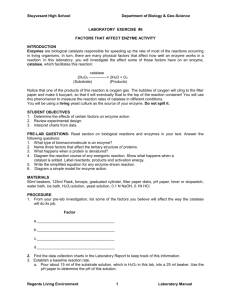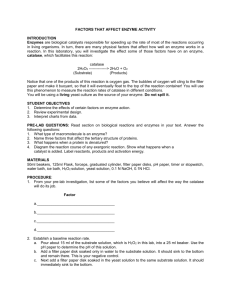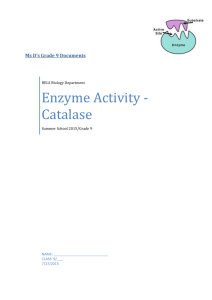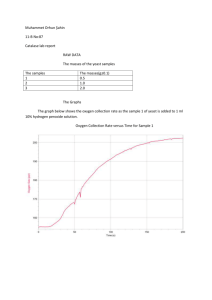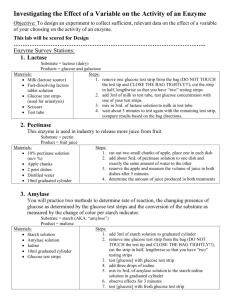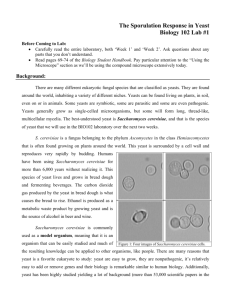Name:
advertisement
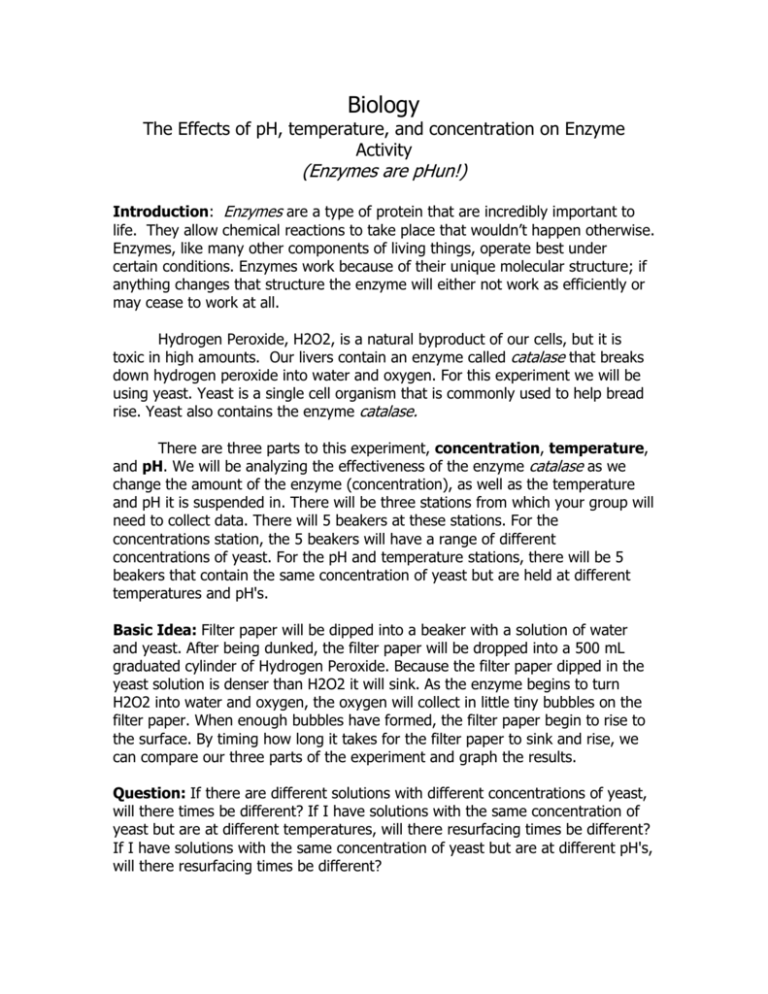
Biology The Effects of pH, temperature, and concentration on Enzyme Activity (Enzymes are pHun!) Introduction: Enzymes are a type of protein that are incredibly important to life. They allow chemical reactions to take place that wouldn’t happen otherwise. Enzymes, like many other components of living things, operate best under certain conditions. Enzymes work because of their unique molecular structure; if anything changes that structure the enzyme will either not work as efficiently or may cease to work at all. Hydrogen Peroxide, H2O2, is a natural byproduct of our cells, but it is toxic in high amounts. Our livers contain an enzyme called catalase that breaks down hydrogen peroxide into water and oxygen. For this experiment we will be using yeast. Yeast is a single cell organism that is commonly used to help bread rise. Yeast also contains the enzyme catalase. There are three parts to this experiment, concentration, temperature, and pH. We will be analyzing the effectiveness of the enzyme catalase as we change the amount of the enzyme (concentration), as well as the temperature and pH it is suspended in. There will be three stations from which your group will need to collect data. There will 5 beakers at these stations. For the concentrations station, the 5 beakers will have a range of different concentrations of yeast. For the pH and temperature stations, there will be 5 beakers that contain the same concentration of yeast but are held at different temperatures and pH's. Basic Idea: Filter paper will be dipped into a beaker with a solution of water and yeast. After being dunked, the filter paper will be dropped into a 500 mL graduated cylinder of Hydrogen Peroxide. Because the filter paper dipped in the yeast solution is denser than H2O2 it will sink. As the enzyme begins to turn H2O2 into water and oxygen, the oxygen will collect in little tiny bubbles on the filter paper. When enough bubbles have formed, the filter paper begin to rise to the surface. By timing how long it takes for the filter paper to sink and rise, we can compare our three parts of the experiment and graph the results. Question: If there are different solutions with different concentrations of yeast, will there times be different? If I have solutions with the same concentration of yeast but are at different temperatures, will there resurfacing times be different? If I have solutions with the same concentration of yeast but are at different pH's, will there resurfacing times be different? Scientific Method: You will be responsible for a laboratory write-up. You will be working in groups, however, each individual will be responsible for turning in their lab write-up. For this, you will be responsible for background information, question, hypothesis, experiment, data collection, analysis, results and conclusion. We will then share or talk about these as a class. You will be responsible to keep a laboratory notebook, this can be as simple as a group of papers stapled together, however, your notebook will be organized and include the things listed above. Below is a guide to how your notebook can be written, head the sections accordingly and follow the prompts. In order to participate in the laboratory and receive a grade, your prelab must be complete. This should include: Background, Question, Hypothesis, Data Collection (setup). Prelab: Background: In general, when conducting an experiment it is nice to have background knowledge of the concepts that are being tested. For our purpose, you will write about 1/2 a page, 2-3 good paragraphs.? In the background, you should include: what is an enzyme, what can effect an enzyme (temperature, pH, concentration) and why it has that effect, what does an enzyme do to the activation energy (energy require to start an chemical reaction) and finally why enzymes are important. Question: Before a scientist starts an experiment, a scientist stubbles across something that intrigues them. They start wondering and thinking, how does that work, or why does that do that. This is where science starts and this is what science is all about, forming questions and trying to answer them. For this experiment, your question has already been dictated, (it's a cruel world where the adults are in charge, deal with it). Any who, please rewrite the question for this experiment in your own words. This should include the 3 parts of the lab. Hypothesis: Please review what a hypothesis is and write one for each of the three parts of this lab, concentration, pH and temperature. Yes, one for each. In order to get full credit for this section, your hypothesis will address why you think the following will happen. The why is the important part, this is what makes it a hypothesis rather than a guess. Please be thorough. Data Collection: For this section, you will need to make a data table for the three parts of the experiment. I would make a data table for 1 part followed by a space below for a graph and then do the next part followed by last part. You should label your data table and graph. Also, your graph MUST have a proper title, both axis's should labeled and units where appropriate. Also, you should have the independent variable on the X-axis and the dependent variable on the Y-axis, if you need help with this, please ask. Table 1: Concentration Concentration Seconds/float Graph 1: Concentration vs seconds/float Do not number or label graph until experiment. Repeat this format for the 2 other parts of your experiment. Leave appropriate spaces. Analysis: This section need not be written in your laboratory notebook, but think about your data. What does it indicate? Are there any outliers or mistakes in your data or collection methods that may have skewed your data. Are there any trends. Does the data support or not support your hypothesis. Results: This section is used to restate your collected data. Be concise, state what the data shows. If there is a trend, state it. This is a fact section and should include empirical data as well as qualitative information. It should be short and sweet. Get to the point but include enough information so that someone reading your results section need not dig through your data collection section to understand the gist or what happened. Do not include your opinions or speculations. Lastly, state whether your hypothesis was supported or not supported. Conclusion: This section is where you explain why your data supports or does not support your hypothesis. This section can include background data but should reference your data. Also, please tell me any methods that you used that may have skewed your results. We call this human error. Could you better standardize your experiment for better results. This is important if anyone wants to repeat your experiment. Sharing your data: As you practiced and got better at you methods through the experiment, it is likely that one of your graphs from the three parts is good. Please let Mr. Mason or myself look at this graph. Every group will have a graph projected for the class and we will analyze the data collected. Grading: Please read each section carefully, when asked to include something, please do, these are worth points. By skipping over something, you will lose points and it will affect your grade. Lastly, your answers matter. In science, what you write is important. Think about what you want to write, and do so in a clear concise way.




